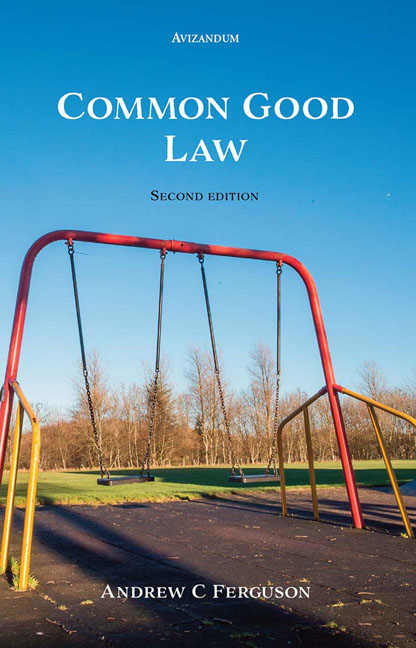Book contents
- Frontmatter
- Contents
- Preface
- Tables of Legislation
- Table of Cases
- 1 Origins and Definitions
- 2 Statutory Framework
- 3 The Administration of the Common Good
- 4 Inalienable Common Good Property
- 5 Classification of Common Good Land
- 6 Appropriation, Alienation and Disposal of Common Good Land
- 7 When Does ‘a Question’ Arise?
- 8 Factors Involved in Allowing Disposal
- 9 Taking a Common Good Case to Court
- 10 Common Good and Community Empowerment
- Appendix I List of Burghs
- Appendix II Disposal, Appropriation and Alienation
- Index
5 - Classification of Common Good Land
Published online by Cambridge University Press: 20 October 2020
- Frontmatter
- Contents
- Preface
- Tables of Legislation
- Table of Cases
- 1 Origins and Definitions
- 2 Statutory Framework
- 3 The Administration of the Common Good
- 4 Inalienable Common Good Property
- 5 Classification of Common Good Land
- 6 Appropriation, Alienation and Disposal of Common Good Land
- 7 When Does ‘a Question’ Arise?
- 8 Factors Involved in Allowing Disposal
- 9 Taking a Common Good Case to Court
- 10 Common Good and Community Empowerment
- Appendix I List of Burghs
- Appendix II Disposal, Appropriation and Alienation
- Index
Summary
When is burgh property part of the common good?
Chapter 4 outlined how some common good property could be classified as being a type of property to which a quality of inalienability, exercisable by the residents of the burgh, applied. It is clear from the case law that such a quality does not apply to all common good property formerly held by burghs. More fundamentally, however, how can it be established in the first place whether former burgh property falls into the common good?
To say the answer to this is not straightforward is something of an understatement. There is no magic formula for identifying the common good property in a burgh. The simplistic approach of checking the former burgh's common good accounts to establish whether any particular property was identified in the accounts as being held as part of the common good has been judicially disapproved of in Cockenzie and Port Seton Community Council v East Lothian District Council, encountered earlier. In that case Lord Osborne said:
Furthermore, it appears to me that the features of the accounts of the burgh which were relied upon by the respondents do not carry them very far. The way in which property is treated in accounts may or may not correctly reflect the classification of that property according to appropriate legal criteria.
In that case, a minute of a finance sub-committee of the burgh council from around the time of the building of the subjects was produced. This showed that the council had decided that it should consider transferring some of the proflts of the swimming pool and buildings connected with it to set up a common good fund for the burgh. It was clear, therefore, as Lord Osborne pointed out, that the council did not consider the swimming pool and buildings to be common good property. Similarly, the accounts of the Burgh of Cockenzie and Port Seton in 1957made no reference to the swimming pool being part of the common good and, again, in 1975, when the swimming pool and buildings appeared reflected in the general income and expenditure accounts of the burgh. Despite all of that the property was held to form part of the common good.
- Type
- Chapter
- Information
- Common Good Law , pp. 73 - 91Publisher: Edinburgh University PressPrint publication year: 2020



